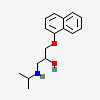The Role of Propranolol in Psychiatry

Propranolol, a non-selective beta-adrenergic blocker, is well-known for its applications in cardiovascular medicine, but its unique effects on the central nervous system have led to significant off-label use in psychiatry. Here, we explore its various roles, mechanisms, and limitations in psychiatric practice.
1. Mechanism of Action in Psychiatry
Propranolol exerts its psychiatric effects by:
1. Blocking beta-adrenergic receptors: This action reduces the somatic symptoms of anxiety, such as tachycardia and tremors, by decreasing the effects of stress hormones like norepinephrine.
2. Crossing the blood-brain barrier: Propranolol interacts with central beta receptors, which might influence emotional memory reconsolidation, particularly relevant in conditions like PTSD.
2. Psychiatric Applications
A. Anxiety Disorders
Propranolol is widely used for managing:
Performance Anxiety: A single dose taken before a stressful event can control physical symptoms like palpitations, tremors, and excessive sweating.
Social Anxiety: By addressing physiological symptoms, propranolol may reduce distress in social situations.
B. Post-Traumatic Stress Disorder (PTSD)
Propranolol may mitigate PTSD symptoms by disrupting the reconsolidation of traumatic memories, particularly when administered soon after trauma exposure.
C. Aggression and Agitation
Propranolol is sometimes employed to manage:
Agitation in dementia: It is used as an adjunctive treatment to control aggression.
Psychiatric disorders with aggression: Its calming effects help reduce impulsive behaviors.
D. Schizophrenia
While not a primary treatment, propranolol may be useful for reducing agitation or managing extrapyramidal symptoms induced by antipsychotic medications.
3. Advantages
Non-sedating: Unlike benzodiazepines, propranolol does not cause sedation or dependency.
Rapid onset for anxiety symptoms: Its effects on physical symptoms of anxiety manifest within 30-60 minutes.
4. Limitations and Considerations
1. Symptomatic Relief: Propranolol targets physical symptoms rather than the psychological core of anxiety disorders.
2. Off-Label Use: Many psychiatric applications are not FDA-approved, necessitating informed consent.
3. Side Effects: These include hypotension, bradycardia, and fatigue, which may limit its use in some patients.
4. Not for Depressed Patients: Propranolol may exacerbate depressive symptoms in vulnerable individuals.
5. Clinical Insights
Dose Titration: Lower doses are effective for anxiety, typically ranging from 10-40 mg as needed.
Monitoring: Regular follow-up is critical to assess efficacy and monitor side effects.
Conclusion
Propranolol occupies a unique niche in psychiatric practice by offering a non-sedative option for managing the somatic symptoms of anxiety, PTSD, and agitation. While its applications in psychiatry are largely off-label, the evidence supporting its use continues to grow. Careful patient selection and monitoring are essential for maximizing benefits and minimizing risks.
Further research may expand its therapeutic scope, particularly in conditions involving emotional memory modulation and stress-related disorders.